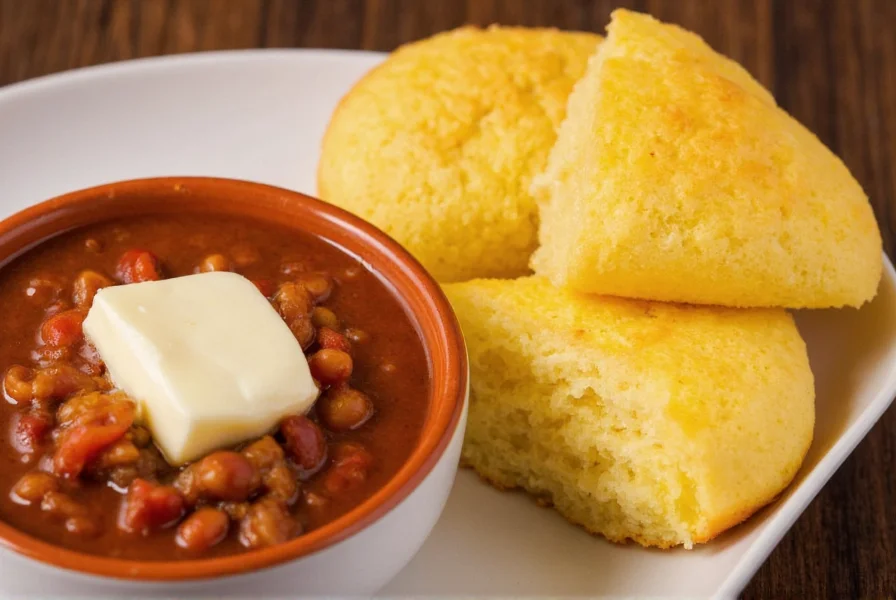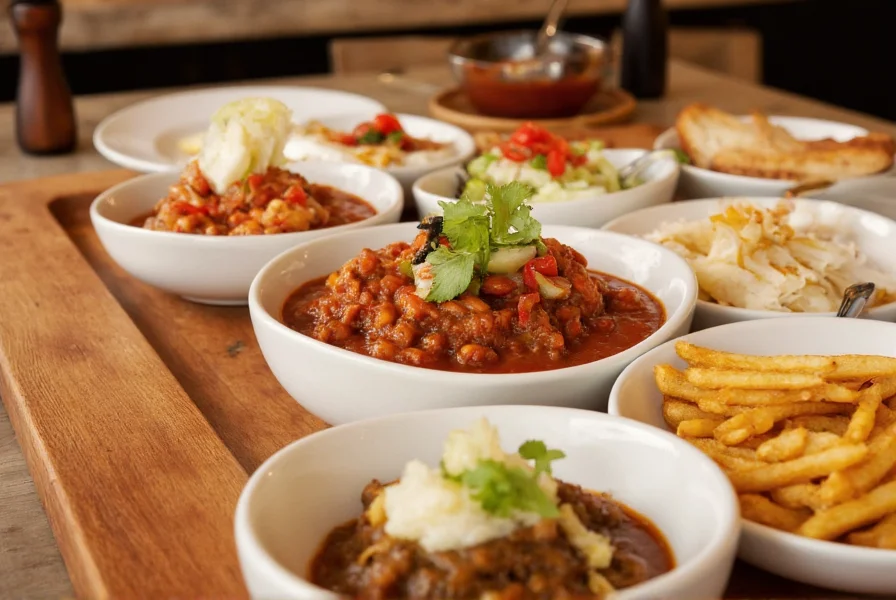The best side dishes to serve with chili include cornbread, rice, baked potatoes, coleslaw, and green salad. These options provide the perfect balance to chili's rich, spicy flavors—starchy sides absorb heat while fresh, crunchy sides offer cooling contrast. For traditional pairings, cornbread is the top choice, while healthier options include quinoa salad or roasted vegetables.
When planning a meal centered around chili, choosing complementary side dishes transforms a simple bowl into a complete, satisfying experience. The right accompaniments don't just fill the plate—they enhance flavor profiles, add textural contrast, and create nutritional balance. Whether you're serving classic beef chili, vegetarian three-bean chili, or white chicken chili, understanding the principles of effective pairing ensures your meal hits all the right notes.
The Science of Perfect Chili Pairings
Chili's complex flavor profile—spicy, savory, and often slightly sweet—creates unique pairing opportunities. The ideal side dishes perform one or more of these functions:
- Temperature contrast - Cool sides balance chili's heat
- Texture variation - Crunchy elements offset chili's thickness
- Flavor balancing - Sweet or acidic sides cut through richness
- Carbohydrate foundation - Starchy bases make chili more filling
Professional chefs emphasize that the best side dishes with chili shouldn't compete with the main attraction but rather support and enhance it. This principle explains why certain classics have endured while others fall by the wayside.
Essential Starchy Sides for Chili
Carbohydrate-based sides form the foundation of most chili meals, providing necessary energy balance and helping moderate the dish's spiciness.
Cornbread: The Undisputed Champion
No discussion of side dishes with chili is complete without mentioning cornbread. This Southern staple offers the perfect combination of:
- Mild sweetness that counters chili's heat
- Crumbly texture ideal for scooping
- Golden crust that contrasts with chili's thickness
- Simple preparation that complements busy cooking schedules
For best results, serve cornbread slightly warm with butter or honey. Variations like jalapeño cornbread add complementary heat, while adding cheese creates a richer pairing for meat-based chili recipes.

Rice: The Versatile Base
Rice serves as an excellent neutral foundation that allows chili's flavors to shine. Consider these approaches:
| Rice Type | Best With | Preparation Tip |
|---|---|---|
| White rice | Traditional beef chili | Rinse thoroughly for fluffier texture |
| Brown rice | Vegetarian chili | Add lime zest for brightness |
| Quinoa | White bean chili | Toast before cooking for nutty flavor |
Fresh & Crunchy Companions
While starchy sides provide foundation, fresh elements offer essential contrast that prevents chili meals from feeling heavy or monotonous.
Coleslaw: The Cooling Counterpoint
A well-made coleslaw provides the ideal temperature and texture contrast to hot chili. The vinegar-based dressing cuts through richness while the crunchy vegetables refresh the palate. For best results with chili:
- Opt for vinegar-based rather than mayo-heavy versions
- Add apple slices for subtle sweetness
- Include red cabbage for visual appeal
- Chill thoroughly before serving
This side dish with chili works particularly well with Cincinnati-style or Texas-style chili that features more complex spice profiles.
Simple Green Salad
A basic salad with light vinaigrette offers the quickest fresh accompaniment. Elevate this easy side dish with chili by:
- Adding avocado slices for creaminess
- Tossing with citrus segments
- Including radish for peppery bite
- Using a lime-cilantro dressing

Creamy Elements for Heat Balance
When serving particularly spicy chili varieties, creamy sides provide essential relief while adding luxurious texture.
Sour Cream and Avocado
These simple additions function as both toppings and side elements. For optimal presentation:
- Serve sour cream in a small ramekin alongside the chili
- Offer avocado slices or guacamole as a separate component
- Consider a cilantro-lime crema for extra flavor dimension
- Provide lime wedges for guests to adjust acidity
These cooling side dishes with chili particularly enhance white chicken chili or spicy bean varieties.
Dietary-Specific Pairings
Modern chili meals often accommodate various dietary needs. Here's how to select appropriate sides:
Gluten-Free Options
For guests avoiding gluten, consider:
- Cassava flour cornbread
- Roasted sweet potatoes
- Quinoa pilaf
- Cauliflower rice
Vegan Pairings
When serving vegetarian or vegan chili:
- Coconut yogurt instead of sour cream
- Avocado-based dressings
- Roasted root vegetables
- Black bean cornbread
Timing Your Meal Preparation
Successful chili service requires strategic timing. Follow this sequence:
- Start with sides requiring longest cooking time (baked potatoes, cornbread)
- Prepare fresh elements (salads, slaws) 30-60 minutes before serving
- Reheat chili just before serving to maintain optimal texture
- Set out cooling elements (sour cream, avocado) immediately before serving
This approach ensures all components arrive at the table at their peak quality, creating the best possible dining experience with your chili and sides.
Frequently Asked Questions
What is the most traditional side dish to serve with chili?
Cornbread is widely considered the most traditional side dish with chili, particularly in Southern and Southwestern American cuisine. Its slightly sweet flavor and crumbly texture perfectly complement chili's spiciness and richness. This pairing dates back to 19th century Texas where both foods were pantry staples for cowboys and settlers.
Can I serve pasta as a side with chili?
Yes, certain pasta types work well as side dishes with chili. Small pasta shapes like orzo or ditalini provide a neutral base that absorbs chili flavors without overwhelming them. For meat-based chili, consider pairing with a simple buttered pasta, while vegetarian chili pairs nicely with lemon-herb pasta. Avoid heavy tomato-based pasta sauces as they compete with chili's flavor profile.
What side dishes go well with white chicken chili?
White chicken chili pairs exceptionally well with lighter sides that complement its creamy texture and mild heat. Recommended options include cilantro-lime rice, avocado salad, roasted corn, and flour tortillas. The bright, fresh flavors balance the richness of the white bean and chicken base while providing textural contrast to the smooth chili.
How can I make side dishes with chili more nutritious?
To boost nutrition in side dishes with chili, incorporate whole grains like quinoa or brown rice instead of refined carbohydrates. Add roasted vegetables such as sweet potatoes or Brussels sprouts for extra fiber and vitamins. Include fresh vegetable salads with vinaigrette dressings rather than creamy options. For traditional cornbread, substitute part of the flour with whole wheat or add grated zucchini or carrots to increase vegetable content without compromising texture.
What sides should I avoid serving with spicy chili?
When serving particularly spicy chili, avoid sides that amplify heat rather than balance it. Steer clear of additional spicy elements like jalapeño cornbread or hot sauces on the side. Also avoid overly sweet sides that might clash with the savory profile, such as candied yams. Instead, focus on cooling, neutral, or slightly acidic accompaniments that provide relief from the heat while enhancing the overall flavor experience.











 浙公网安备
33010002000092号
浙公网安备
33010002000092号 浙B2-20120091-4
浙B2-20120091-4